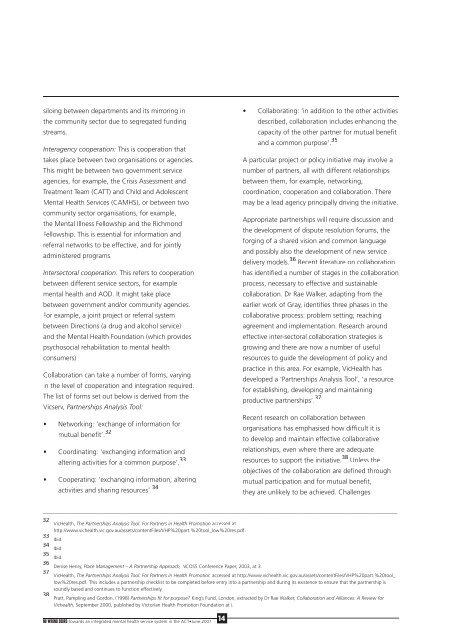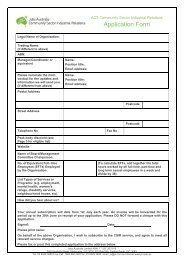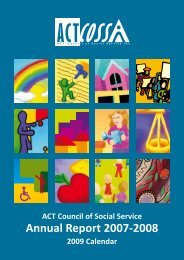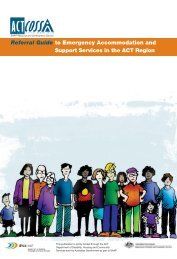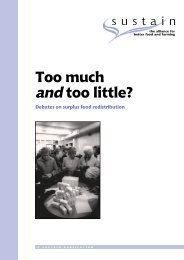actcoss text final.indd - ACT Council of Social Service
actcoss text final.indd - ACT Council of Social Service
actcoss text final.indd - ACT Council of Social Service
Create successful ePaper yourself
Turn your PDF publications into a flip-book with our unique Google optimized e-Paper software.
• Collaborating: ‘in addition to the other activities<br />
siloing between departments and its mirroring in<br />
activities and sharing resources’. 34 they are unlikely to be achieved. Challenges<br />
the community sector due to segregated funding<br />
streams.<br />
described, collaboration includes enhancing the<br />
capacity <strong>of</strong> the other partner for mutual benefit<br />
and a common purpose’. 35<br />
Interagency cooperation: This is cooperation that<br />
takes place between two organisations or agencies.<br />
This might be between two government service<br />
agencies, for example, the Crisis Assessment and<br />
Treatment Team (CATT) and Child and Adolescent<br />
Mental Health <strong>Service</strong>s (CAMHS), or between two<br />
A particular project or policy initiative may involve a<br />
number <strong>of</strong> partners, all with different relationships<br />
between them, for example, networking,<br />
coordination, cooperation and collaboration. There<br />
may be a lead agency principally driving the initiative.<br />
community sector organisations, for example,<br />
Appropriate partnerships will require discussion and<br />
the Mental Illness Fellowship and the Richmond<br />
the development <strong>of</strong> dispute resolution forums, the<br />
Fellowship. This is essential for information and<br />
forging <strong>of</strong> a shared vision and common language<br />
referral networks to be effective, and for jointly<br />
and possibly also the development <strong>of</strong> new service<br />
administered programs.<br />
delivery models. 36 Recent literature on collaboration<br />
Intersectoral cooperation: This refers to cooperation<br />
between different service sectors, for example<br />
mental health and AOD. It might take place<br />
between government and/or community agencies.<br />
For example, a joint project or referral system<br />
between Directions (a drug and alcohol service)<br />
and the Mental Health Foundation (which provides<br />
psychosocial rehabilitation to mental health<br />
consumers).<br />
has identified a number <strong>of</strong> stages in the collaboration<br />
process, necessary to effective and sustainable<br />
collaboration. Dr Rae Walker, adapting from the<br />
earlier work <strong>of</strong> Gray, identifies three phases in the<br />
collaborative process: problem setting; reaching<br />
agreement and implementation. Research around<br />
effective inter-sectoral collaboration strategies is<br />
growing and there are now a number <strong>of</strong> useful<br />
resources to guide the development <strong>of</strong> policy and<br />
practice in this area. For example, VicHealth has<br />
Collaboration can take a number <strong>of</strong> forms, varying<br />
developed a ‘Partnerships Analysis Tool’, ‘a resource<br />
in the level <strong>of</strong> cooperation and integration required.<br />
for establishing, developing and maintaining<br />
The list <strong>of</strong> forms set out below is derived from the<br />
productive partnerships’. 37<br />
Vicserv, Partnerships Analysis Tool:<br />
Recent research on collaboration between<br />
• Networking: ‘exchange <strong>of</strong> information for<br />
mutual benefit’. 32<br />
organisations has emphasised how difficult it is<br />
to develop and maintain effective collaborative<br />
• Coordinating: ‘exchanging information and<br />
altering activities for a common purpose’. 33<br />
relationships, even where there are adequate<br />
resources to support the initiative. 38 Unless the<br />
• Cooperating: ‘exchanging information, altering<br />
objectives <strong>of</strong> the collaboration are defined through<br />
mutual participation and for mutual benefit,<br />
___________________________________________________________________________________________________________________________<br />
32 VicHealth, The Partnerships Analysis Tool: For Partners in Health Promotion accessed at<br />
http://www.vichealth.vic.gov.au/assets/contentFiles/VHP%20part.%20tool_low%20res.pdf.<br />
33 Ibid.<br />
34 Ibid.<br />
35 Ibid.<br />
36 Denise Henry, Place Management – A Partnership Approach, NCOSS Conference Paper, 2003, at 3.<br />
37 VicHealth, The Partnerships Analysis Tool: For Partners in Health Promotion accessed at http://www.vichealth.vic.gov.au/assets/contentFiles/VHP%20part.%20tool_<br />
low%20res.pdf. This includes a partnership checklist to be completed before entry into a partnership and during its existence to ensure that the partnership is<br />
soundly based and continues to function effectively.<br />
38 Pratt, Pampling and Gordon, (1998) Partnerships fit for purpose? King’s Fund, London, extracted by Dr Rae Walker, Collaboration and Alliances: A Review for<br />
Vichealth, September 2000, published by Victorian Health Promotion Foundation at i.<br />
NO WRONG DOORS Towards an integrated mental health service system in the <strong>ACT</strong>•June 2007<br />
14


